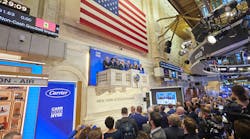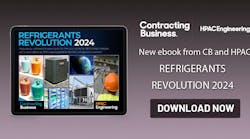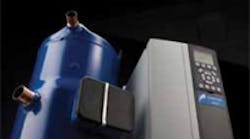It’s no secret that energy consumption is on the rise throughout the world. At the current growth rate, predictions by the Edison Electric Institute indicate, the United States alone could see an increase in usage as high as 31 percent by 2035—and that is in the face of a global economic crisis.
The good news is that the broadly deployed efforts of industry, utilities, advocacy groups, and government to improve energy efficiency are proving effective for reducing overall energy use. However, these efforts have been less effective at managing peak load—times when the demand for energy on the electric utility is extremely high.
Peak-load periods are costly, stress the electric grid, equate to higher energy prices for end users, and can also pose potential threats for blackouts or brownouts as the grid becomes overloaded, making it difficult for a utility to deliver energy reliably and safely. While end users can do their part to reduce total energy use, there is a greater opportunity for the HVAC industry and electric utilities to partner and collaborate to implement smart-grid-ready and available-now technologies such as variable-speed systems. Such steps can make large strides in reducing peak demand and providing greater control.
Depending on the region of the United States, air conditioning can account for more than 60 percent of summer peak-load power. Yet, the variable-speed systems that are effective in managing peak loads have experienced very limited deployment in the market, challenged by the hurdles of first costs, comparatively low energy rates, and building owners’ long history of experience with conventional, fixed-speed systems. Variable-speed systems are demonstrated solutions, with the ability to address air conditioning as the largest energy-use segment while also providing demand-response capabilities. These values benefit energy users and utilities.
Achieving High Energy Efficiency
Variable-speed compressors, fans, and blowers significantly reduce energy use by precisely matching a system’s level of operation to the cooling load, which can vary throughout the day based on the building’s needs. They can maintain occupant set point without resorting to inefficient full-on, full-off system cycles. This on/off cycle, which is a common function of popular fixed-speed air-conditioning systems, means the system always is running at full load for a given ambient condition, whereas an air-conditioning system utilizing variable-speed technology is capable of operating under much more efficient part-load conditions.
Variable-speed capabilities are being implemented in applications such as chillers, rooftop units, packaged units, industrial chillers, air or water heat pumps, and variable-refrigerant-flow (VRF) systems and deliver as much as 30 percent greater energy efficiency than fixed-speed systems. These energy-efficient technologies aid in achieving the latest building-efficiency standards, including ANSI/ASHRAE/IES Standard 90.1, Energy Standard for Buildings Except Low-Rise Residential Buildings, and future ASHRAE/IES Standard 90.1 targets.
Riding Parallel Value Streams
The value stream for variable-speed air conditioning is robust and two fold, providing both short-term and long-term benefits to building owners and electric utilities.
For the energy consumer, a variable-speed system provides significant energy savings. With the avoidance of full-on, full-off cycles, space comfort is improved drastically through tighter temperature control, enhanced dehumidification, lower noise levels, and improved heating.
For an electric utility, variable-speed technology not only improves system energy use, it is smart-grid-ready. This means it is better able to facilitate peak-load reductions through demand-response or price-response capabilities. By providing a continuously adjustable output, the local utility is able to adjust an air-conditioning system’s speed to better accommodate periods of peak load and, therefore, reduce demand without much noticeable impact on the occupants’ level of comfort. The use of variable-frequency drives (VFDs) to achieve variable-speed control also improves distribution power factor. Power quality is improved by virtually eliminating compressor in-rush current, which in part creates conspicuous light flickers and limits load-control deployment on utility distribution circuits.
As renewable-energy sources become further integrated into electric utilities’ energy packages, variable-speed technology will enable the agile and timely regulation of a load to match fluctuating renewables generation. This will help offset the requirement for high-cost “spinning reserves”—generators operating with no instantaneously available load—at times when solar- or wind-power outputs decrease because of naturally occurring lulls in production or availability. By eliminating some of the variability associated with renewable-energy sources, variable-speed could, in fact, help facilitate the penetration and deployment of renewables as a viable and reliable energy source in the United States.
Utility demand-response programs also could harbor additional financial incentives for building owners who allow the electric utility to adjust their energy use based on peak and off-peak load conditions.
Becoming Smart-Grid-Ready
The United States’ transformation to the smart grid was jump-started in 2007 by a $4.9 billion infusion of American Recovery and Reinvestment Act stimulus funds, which was designed to support “shovel-ready” smart-grid projects and regional smart-grid demonstrations. The governments of China, Japan, South Korea, Germany, and the United Kingdom are among those that are investing in smart grids for their countries. This raised the stakes for the United States to remain competitive in the development of more smart grid-ready technologies and to make its electric grid as reliable and environmentally friendly as possible.
What’s more, Japan has taken to variable-speed technology to enhance its power grid and provide greater indoor comfort. High electric rates and a constrained grid in nearby China also is rapidly accelerating penetration there.
A 2011 study of U.S. building owners, consulting engineers, and product manufacturers (bit.ly/smartgridreport) sought to define some of the initial obstacles standing in the way of a full deployment of the smart grid in the United States, especially from the perspective of the commercial-building owner.
The report cited the U.S. Department of Energy (DOE) statistic that commercial buildings are responsible for about 18 percent of the total U.S. energy budget, accounting for approximately $139 billion in annual electric costs alone. This electricity bill does not include the billions of dollars that utilities and building owners are investing in technologies and services that help make the facility more energy efficient.
Yet, in spite of the smart grid’s potential, the findings of the study indicate a need for more education from utilities on the value of the smart grid to end users, as well as concerns about first costs of the new technology. It also found that the top motivating factors for deploying smart-grid technologies such as variable-speed systems include financial incentives, significantly reduced electricity rates, and more effective communications and data from utilities.
When asked about the perceived barriers of a full-scale smart-grid deployment for building owners, respondents indicated that organizational issues, followed by technology issues and cost, clearly stood in the way.
The drivers included lower electricity costs and having more and better access to information with which to manage energy, which could further help reduce energy costs. Respondents also noted the importance of the smart grid’s ability to shorten the duration of power outages, which can cost some $150 billion each year, according to the DOE, and can be critical and detrimental to the productivity of business —a benefit strongly correlated to the addition of variable-speed technology.
Ultimately, by controlling peak demand and energy use, smart technologies and the smart grid help to offset the need to build costly power plants.
The Deployment Challenge
If variable-speed technologies offer such substantial benefits, why have they not penetrated the U.S. market?
First, because most electric rates in the United States are substantially lower than in Japan, Europe, and other regions, U.S. building owners do not have the same economic motivation to switch to highly efficient equipment. Beyond that, traditional on-off systems, which require lower first-cost investments, have an inertia that is difficult to change.
Yet, there are several manufacturers that now offer variable-speed systems for the U.S. market, while others are in the process of developing them as VFD systems become more affordable. It can be expected that as these systems become more available, interest will grow. However, financial incentives are needed to motivate building owners. These may come in the form of federal or state tax incentives, but the on-and-off nature of tax incentives has not been enough to stimulate the long-term transition to variable speed.
Utility incentive programs provide a boost, especially when combined with tax incentives. Many utilities have regulatory mandates to provide energy-efficiency incentives, and many also provide incentives for peak-load reduction technologies, called demand-response incentives. But often the energy-efficiency incentives and demand-response incentives are not coordinated, as they often are under separate regulatory authority from states’ public-service commissions. Coordination is needed to ensure that incentives fully recognize both the energy-efficiency and demand-response benefits of variable-speed technologies and other load-shifting technologies. Regulators in some states are beginning to recognize the importance of this, so it is feasible to expect enhanced incentive structures in the years ahead.
It is increasingly clear there is a need for a holistic approach, including integrated utility demand-side management programs, public policy, and consumer education.
Robert Wilkins is vice president, public affairs, Danfoss.








